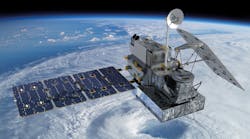Microwave Technology Extends Satellite Precipitation Coverage
Weather radars have been in use since the 1940s. Yet there have been numerous technical challenges in measuring rainfall from space. To address some of these issues, the Global Precipitation Measurement (GPM) Core Observatory satellite—which is set to launch in February 2014--will calibrate measurements to see when, where, and how much it rains and snows around the world. In doing so, it will rely on a global microwave imager (GMI) and dual-frequency precipitation radar (DPR).
GPM, which is part of the update for the Tropical Rainfall Measuring Mission (TRMM), is a partnership between NASA and Japan Aerospace Exploration Agency (JAXA). Launched in 1977, TRMM measures moderate and heavy rainfall in the tropics at different times during the day. GPM will extend those observations to higher latitudes with coverage from the Antarctic Circle to the Arctic Circle.
The upgraded design of the GPM satellite utilizes an advanced version of TRMM’s sensing package. That upgrade leverages a microwave imager and dual-frequency precipitation radar. The radar will provide data like the size and distribution of precipitation particles, layer by layer, within clouds. This upgraded radar was developed by JAXA and the National Institute of Information and Communication Technology in Tokyo. It operates at both the Ku- and Ka-bands. The radar has 190-kb/s bandwidth over the 1553B spacecraft data bus. It uses a variable pulse-repetition frequency technique to realize 0.2 mm/h sensitivity.
The other major component in this upgrade, the microwave imager, observes rainfall and snowfall at 13 different frequencies within all cloud layers. The GMI instrument, which was built by Ball Aerospace, is a multichannel, conical, scanning microwave radiometer. Its 13 channels span 10 to 183 GHz (including four channels that are higher in frequency than what can be reached with the TRMM imager). At 32 rotations per minute, microwave radiometric brightness measurements will be gathered over a 140-deg. sector centered about the spacecraft’s ground-track vector. The GMI also utilizes feed horns and RF receivers to focus the reflected RF energy associated with Earth’s precipitation—including moisture from humidity, dew, snow, and rain—and send it down to waveguides and the receiver subsystem.
The Core Observatory satellite’s RF-communications subsystem provides S-band communications to and from the ground systems. The data collected by the GMI will be continuously returned by a Tracking and Data Relay Satellite System (TDRSS) multiple-access link. Data collected by the DPR will be returned one time per orbit by a TDRSS single-access link. Contingency communications are provided through an omnidirectional S-band antenna link, which is connected to NASA’s Near Earth Network.
